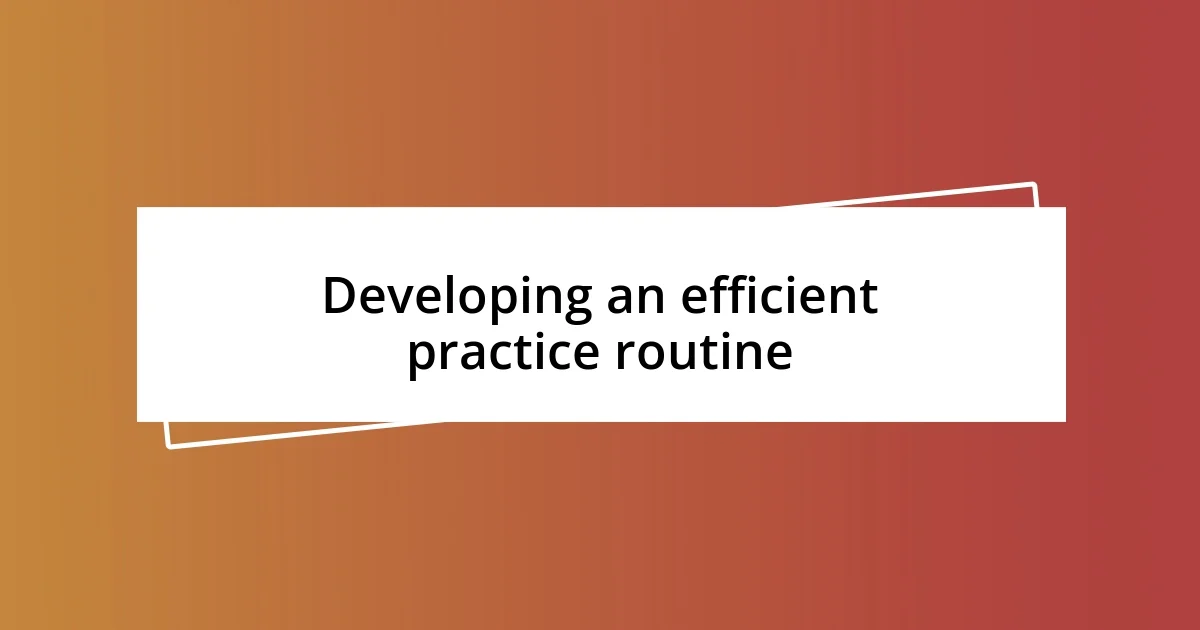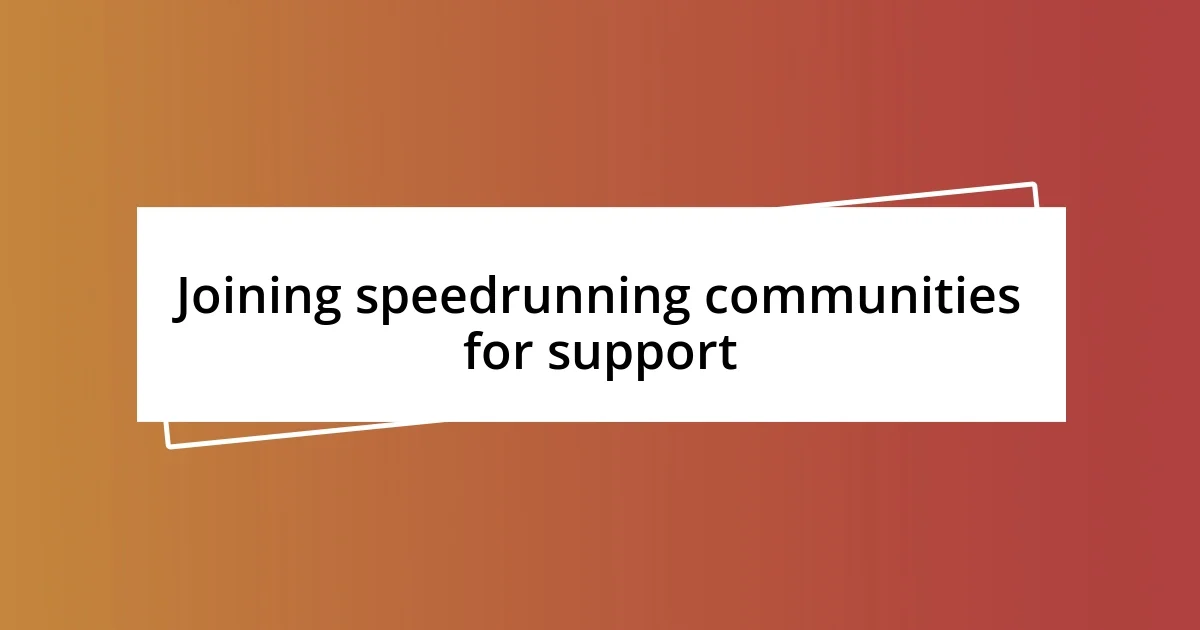Key takeaways:
- Speedrunning involves completing games as quickly as possible, with various categories (any% vs. 100%) influencing strategies and goals.
- Building a supportive community enhances the speedrunning experience through shared tips, collaboration, and motivation from fellow enthusiasts.
- Setting personal goals, developing focused practice routines, and analyzing techniques are essential for continuous improvement in speedrunning performance.

Understanding speedrunning basics
Speedrunning, at its core, is the practice of completing a video game as quickly as possible, often utilizing specific techniques to shave off precious seconds. I still remember the rush I felt when I first attempted to speedrun a game I loved—it was like experiencing it all over again, but with a newfound purpose. Can you imagine racing against the clock where every second counts, and every move is scrutinized for efficiency?
To really grasp the basics of speedrunning, you need to understand the different categories it offers. For instance, in some games, there are any% runs, meaning you can complete it in any way possible, while others may require 100% completion. I once struggled with a game that had multiple categories, and switching between them felt like learning an entirely new game—such a challenge, but so rewarding when I managed to beat my own times!
One of the most exciting aspects of speedrunning is the community that surrounds it. It’s filled with enthusiasts who share tips, strategies, and even emotional support. I still cherish the moment a fellow speedrunner reached out to help me perfect a tricky segment—I felt a sense of belonging that transformed my experience from a solitary endeavor to a shared passion. Isn’t it amazing how a simple love for gaming can foster such a vibrant, collaborative environment?

Choosing new titles to speedrun
Choosing a new title to speedrun can feel both exhilarating and daunting. I still remember the first time I looked at a game that caught my eye for its speedrunning potential. It wasn’t just about how fast I could play it; I had to consider factors like the community surrounding the game and the availability of resources. Diving deep into a new title enriched my gaming journey.
When selecting a new game, I often weigh these crucial aspects:
- Familiarity: How well do I know the game already?
- Community Support: Is there a specific community that thrives around it?
- Categories: What types of runs are available, and do they match my interests?
- Resource Availability: Are there guides, tutorials, or streams I can learn from?
- Personal Enjoyment: Is it a game I genuinely enjoy playing?
Each of these considerations helps shape my decision, making the experience not just about speed but about cultivating a deeper connection with the game.

Setting personal goals and benchmarks
Setting personal goals in speedrunning is crucial for tracking progress and maintaining motivation. I remember when I established my first goal of completing a run under 30 minutes—a seemingly impossible feat at the time. Setting a benchmark like this kept me focused on improving specific segments, whether it was mastering a particular trick or optimizing my route. Each time I achieved a small milestone, I experienced a rush of accomplishment that fueled my desire to push even further.
Creating benchmarks also allows you to compare your progress over time. I often jot down my times after every practice session and analyze where I can improve. It’s a powerful motivator to see how far I’ve come, even if it’s just a few seconds faster. To visualize my progress, I developed a table that tracked my best times for different segments, comparing my achievements as I honed my skills.
| Segment | Best Time (Minutes:Seconds) |
|---|---|
| Level 1 | 02:10 |
| Level 2 | 03:45 |
| Boss Fight | 01:30 |
| Total Time | 30:00 |
Reflecting on past benchmarks has helped me adjust my future goals. Each new title has its unique challenges, and I often find myself revisiting my initial goals to tailor them to the game’s specifics. It’s a continual learning process that not only sharpens my gameplay but also deepens my connection to each title I choose to speedrun. How do you approach setting your own goals, and what motivates you to achieve them? I believe sharing our experiences could create a supportive community where everyone strives to reach their personal bests.

Developing an efficient practice routine
Establishing an efficient practice routine in speedrunning is one of those things that can make or break your experience. Early in my speedrunning journey, I discovered that dedicating specific time blocks to practice made all the difference. Instead of playing casually, I set aside an hour each day solely for focused practice. This shift transformed my sessions from random gameplay into purposeful training where I could hone specific skills, like nailing a tricky jump or timing a sequence perfectly.
I learned the importance of breaking down each run into manageable segments. For instance, after repeatedly struggling with a particular level in a new title, I chose to isolate that segment and practice it in isolation until I felt confident. This approach was eye-opening! It not only accelerated my learning but also built my confidence. Have you ever felt overwhelmed by a challenging segment? Trust me, taking that step back to focus on one part at a time really helped me regain my momentum.
Another key factor emerged when I began to incorporate video analysis into my practice. Watching my own runs, I could identify mistakes and areas to improve that I might have missed in real-time. I’ll admit, it was sometimes tough to face those errors, but each critique turned into a learning opportunity. How many times have you watched your gameplay and thought, “Wow, I can do better?” That realization drove me to refine my strategies and ultimately reach new personal bests.

Analyzing techniques and strategies
Speedrunning demands a deep understanding of various techniques and strategies to achieve the fastest times. One of the standout strategies I often relied on is the optimization of route choices. While running through levels, I noticed how different paths could save precious seconds. For instance, in a recent title, I discovered a less-traveled route that bypassed several obstacles. This wasn’t just luck; it required spending time experimenting and analyzing each segment. Have you ever stumbled upon a shortcut that changed your entire approach? Those moments are exhilarating because they highlight the potential for innovation in speedrunning.
Another technique I frequently employed is mastering movement mechanics, which can be game-specific yet universally essential. In one game, I was struggling with a particular jump that always sent me crashing down. After countless attempts, I began to truly dissect my timing and position. The breakthrough came when I realized that a slight adjustment in my character’s angle made all the difference. Each small improvement can feel monumental, igniting that fire of determination in me. Isn’t it fascinating how one tiny tweak can revolutionize your performance?
Collaboration with the community has also played a significant role in developing my strategies. I remember sharing my approach with fellow speedrunners and receiving invaluable feedback that reshaped my understanding of optimal play. Watching others tackle the same game opened my eyes to new perspectives. How often do we overlook the power of collaboration? In speedrunning, it’s clear that learning from others not only refines our own techniques but also enriches the entire community. Each run becomes a collective journey toward mastery.

Joining speedrunning communities for support
Joining a speedrunning community can be one of the most rewarding experiences I’ve had. When I first started, I was a bit hesitant to reach out. However, once I did, I found a treasure trove of advice, support, and camaraderie that I didn’t know I was missing. Have you ever felt alone in a new hobby? Trust me, connecting with others who share your passion can boost your motivation in ways you wouldn’t believe.
I vividly remember my first chat in a speedrunning Discord server. I mentioned my struggles with a particularly tricky game, and within minutes, I had a handful of seasoned runners offering tips, resources, and even inviting me to join practice sessions. It’s incredible how quickly a shared experience can foster a sense of belonging. Have you experienced that feeling of being uplifted by a community? For me, it’s those little victories that keep me coming back to these groups.
Moreover, participating in community events, like races or casual speedrunning nights, ignited my competitive spirit. There’s something uniquely exhilarating about racing against others while sharing live commentary and laughter. I recall one evening where I had an unexpected meltdown during my run, and rather than feeling ashamed, the supportive reactions from fellow runners made me realize that everyone embraces those moments. Isn’t it refreshing to know that, in this community, mistakes are just stepping stones to improvement? The encouragement and shared triumphs in these environments truly enhance the speedrunning journey.

Sharing your speedrunning journey online
Sharing my speedrunning journey online has been both enlightening and immensely rewarding. I remember the first time I decided to stream my attempts; it was nerve-wracking, clicking that “Go Live” button, my heart racing as I anticipated both cheers and critiques. The moment my first viewer chimed in was a game-changer for me. Have you ever felt the rush of validation and fear at the same time? I realized that sharing my struggles made me more relatable and created a connection with others who were fighting similar battles.
Becoming active on platforms like Twitch and YouTube allowed me to showcase my progress, but it was the engagement with my audience that truly made a difference. I found that viewers not only celebrated my victories but also provided constructive feedback that helped refine my runs. One viewer pointed out a technique I had overlooked, which turned my once-stubborn PB (personal best) into a new benchmark. Has anyone ever given you that one piece of advice that alters your entire strategy? Honestly, even the smallest tip can spark significant improvement.
Additionally, documenting my speedrunning endeavors through social media has been eye-opening. As I shared highlights and lowlights, I discovered that I wasn’t alone in my experiences. The encouragement from my followers turned moments of failure into collective learning experiences. For instance, when I missed an elusive record, my followers shared their own mishaps. It felt comforting to know that each run, whether a triumph or a setback, contributed to a larger narrative. Isn’t it fascinating how sharing our stories, both the ups and downs, can forge deep connections within the speedrunning community?














